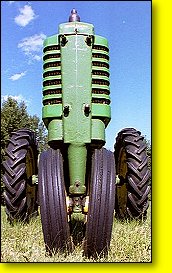- MODEL D
- This was the first tractor produced in the Waterloo factory under the John Deere name. It was introduced in late 1923 as a 1924 model. The D was considered a "wheatland" tractor, designed for pulling plows and for providing the power to threshers. The Model D stayed in the John Deere line longer than any other tractor in its history. The last ones were put together AFTER the production line closed in 1953.
- MODEL C
- John Deere needed a smaller, more versatile tractor than the Model D in order to compete with the Farmall "rowcrop" tractors. The C was the "prototype" for the Model GP tractor. Only about 110 of these were manufactured. I wish I had one!!
- MODEL GP
- The GP, or "General Purpose" came out in 1928. Unfortunately it sold in fewer numbers than even the Model D because its three-row implement configuration did NOT catch on. There were some tricycle and wide-tread variations of the GP. The final GP's were built in 1935.
- MODEL A
- John Deere was finally able to compete with the Farmalls with its new 1934 Model A. This was the company's first real "rowcrop tractor" and one of the most popular models EVER. The A acquired styled sheetmetal in 1939 and the tractors were sold as fast as they could be produced until 1952.
- MODEL B
- The production of this "rowcrop tractor" from 1935 to 1952 surpassed even the Model A to become the largest selling tractor in John Deere's history. This was probably because it was slightly smaller, lighter, and more versatile than the A, used a little less fuel, and cost a little less. It was the perfect choice for a small farm!
- MODEL L
- This was a small "utility tractor" introduced in 1937. The L was manufactured at the "Wagon Works" in Moline, IL. Unlike the tractors manufactured at Waterloo, it had a VERTICAL two-cylinder engine, a driveshaft, and a FOOT clutch. A slightly bigger version of the L was introduced in 1941 and it was designated as the Model LA. Both models were discontinued in 1946.
- MODEL G
- New in late 1937, for the 1938 model year, the G became a big brother to the A. Styling was not added until 1942, and at that point it was called the GM in order to get the price increase past the War Price Board. After the war it once again became the G. It was the SAME tractor until it was replaced by the Model 70 in 1953.
- MODEL H
- In 1939 there came along a little brother to the Model B! It was designed for light jobs like cultivating and it went a long way towards replacing the horse on small farms.
- MODEL M
- This tractor was built in the new factory in Dubuque, Iowa in 1947. This was another tractor with the vertical inline engine and driveshaft configuration. The Model M replaced the Model H.
- MODEL R
- John Deere's first diesel tractor finally came out in 1949 and was produced until 1954.
|
 Gene is the Model B "expert" so I have been assigned to talk a little bit about the John Deere two-cylinder tractors OTHER than the Model B. The following is a short description of each tractor in what is affectionately known as "The Letter Series". These are listed in the order in which they were introduced.
Gene is the Model B "expert" so I have been assigned to talk a little bit about the John Deere two-cylinder tractors OTHER than the Model B. The following is a short description of each tractor in what is affectionately known as "The Letter Series". These are listed in the order in which they were introduced.
 This slightly exaggerated front view is a styled Model B, showing the horizontal grill louvers. Many of the "Letter Series" tractors eventually had this style grill. It's impossible to show all of them on this page. Each one has its own page with pictures. If you click on the Models that are underlined, you'll get more information.
This slightly exaggerated front view is a styled Model B, showing the horizontal grill louvers. Many of the "Letter Series" tractors eventually had this style grill. It's impossible to show all of them on this page. Each one has its own page with pictures. If you click on the Models that are underlined, you'll get more information.